check engine light FORD F750 2006 11.G User Guide
[x] Cancel search | Manufacturer: FORD, Model Year: 2006, Model line: F750, Model: FORD F750 2006 11.GPages: 272, PDF Size: 1.86 MB
Page 152 of 272

Before connecting a fast-charger, booster battery or installing a new
battery, make sure the ground polarities of the fast-charger, booster
battery or alternator (when installing a battery) are matched to the
ground polarity of the vehicle battery. Improper usage of the
fast-charger, hook-up of booster battery or installation of a new battery
can cause damage to the electrical system or to the alternator. Do not
attempt to polarize the alternator.
Preparing your vehicle
1.Use only a 12–volt supply to start your vehicle.Do not attach the
jumper cables to the glow plug relay as this could severely damage the
glow plugs, injector driver module and PCM.
2. Do not disconnect the battery of the disabled vehicle as this could
damage the vehicle’s electrical system.
3. Park the booster vehicle close to the hood of the disabled vehicle
making sure the two vehiclesdo nottouch. Set the parking brake on
both vehicles and stay clear of the engine cooling fan and other moving
parts.
4. Check all battery terminals and remove any excessive corrosion before
you attach the battery cables. Ensure that vent caps are tight and level.
5. Turn the heater fan on in both vehicles to protect any electrical
surges. Turn all other accessories off.
Connecting the jumper cables
1. Connect the positive (+) jumper cable to the positive (+) terminal of
the discharged battery.
Note:In the illustrations,lightning boltsare used to designate the
assisting (boosting) battery.
+–+–
2006 F-650/750(f67)
Supplement
USA(fus)
Roadside Emergencies
152
Page 181 of 272

ENGINE COOLING SYSTEM
If your vehicle is equipped with a Caterpillar or Cummins engine,
refer to your engine operator’s manual for engine coolant check and
adding instructions as well as fluid specifications and capacities.
Inspect cooling system daily
Note:The engine coolant reservoir requires air space for expansion
volume. The proper fill level is identified on the reservoir; do not overfill
the reservoir.
To reduce the risk of personal injury or death, use only the
following procedure to remove the pressure-type cap from the
radiator or expansion tank.
1. Always allow the engine to cool first.
2. Wrap a thick, heavy cloth around the cap.
3. Loosen the cap slowly, then pause a moment. This will reduce the risk
of possible scalding by hot water or steam.
4. Continue to unscrew the cap and remove only after pressure in the
radiator is fully released.
Note:If the coolant should get extremely low and the engine very hot,
let the engine cool for approximately 15 minutes before adding coolant.
After the engine has cooled, start the engine and add coolant slowly.
Adding coolant to a hot engine may crack the cylinder head or
crankcase. Never use only water to fill the cooling system.
Adding engine coolant - 6.0L Power Stroke
When adding coolant, make sure it is a 50/50 mixture of engine coolant
and distilled water. Add the mixture to the coolant reservoir,when the
engine is cool, until the appropriate fill level is obtained.
To reduce the risk of personal injury, make sure the engine is
cool before unscrewing the coolant pressure relief cap. The
cooling system is under pressure; steam and hot liquid can come out
forcefully when the cap is loosened slightly.
Do not add engine coolant when the engine is hot. Steam and
scalding liquids released from a hot cooling system can burn you
badly. Also, you can be burned if you spill coolant on hot engine parts.
2006 F-650/750(f67)
Supplement
USA(fus)
Maintenance and Specifications
181
Page 188 of 272
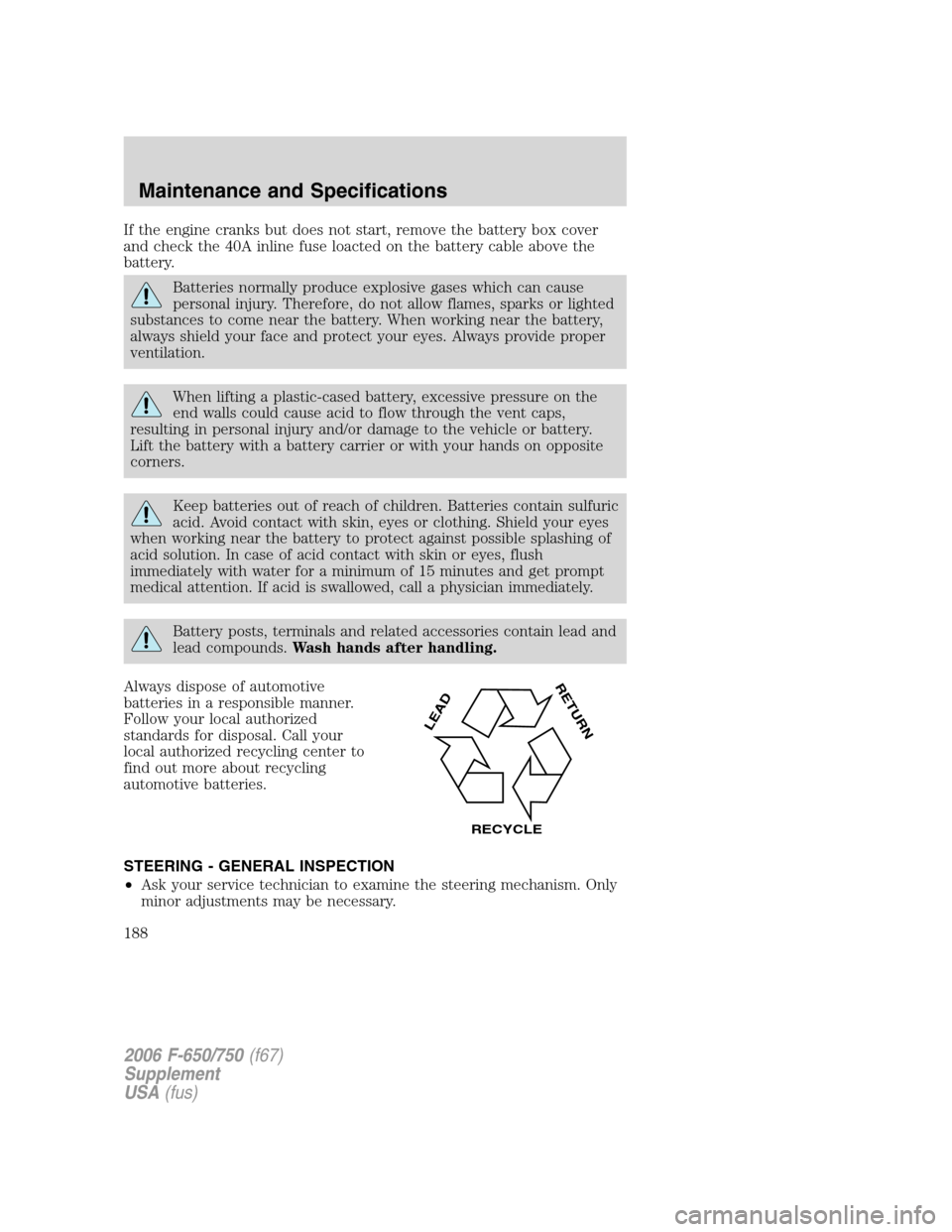
If the engine cranks but does not start, remove the battery box cover
and check the 40A inline fuse loacted on the battery cable above the
battery.
Batteries normally produce explosive gases which can cause
personal injury. Therefore, do not allow flames, sparks or lighted
substances to come near the battery. When working near the battery,
always shield your face and protect your eyes. Always provide proper
ventilation.
When lifting a plastic-cased battery, excessive pressure on the
end walls could cause acid to flow through the vent caps,
resulting in personal injury and/or damage to the vehicle or battery.
Lift the battery with a battery carrier or with your hands on opposite
corners.
Keep batteries out of reach of children. Batteries contain sulfuric
acid. Avoid contact with skin, eyes or clothing. Shield your eyes
when working near the battery to protect against possible splashing of
acid solution. In case of acid contact with skin or eyes, flush
immediately with water for a minimum of 15 minutes and get prompt
medical attention. If acid is swallowed, call a physician immediately.
Battery posts, terminals and related accessories contain lead and
lead compounds.Wash hands after handling.
Always dispose of automotive
batteries in a responsible manner.
Follow your local authorized
standards for disposal. Call your
local authorized recycling center to
find out more about recycling
automotive batteries.
STEERING - GENERAL INSPECTION
•Ask your service technician to examine the steering mechanism. Only
minor adjustments may be necessary.
L
E
A
D
RETURN
RECYCLE
2006 F-650/750(f67)
Supplement
USA(fus)
Maintenance and Specifications
188
Page 194 of 272
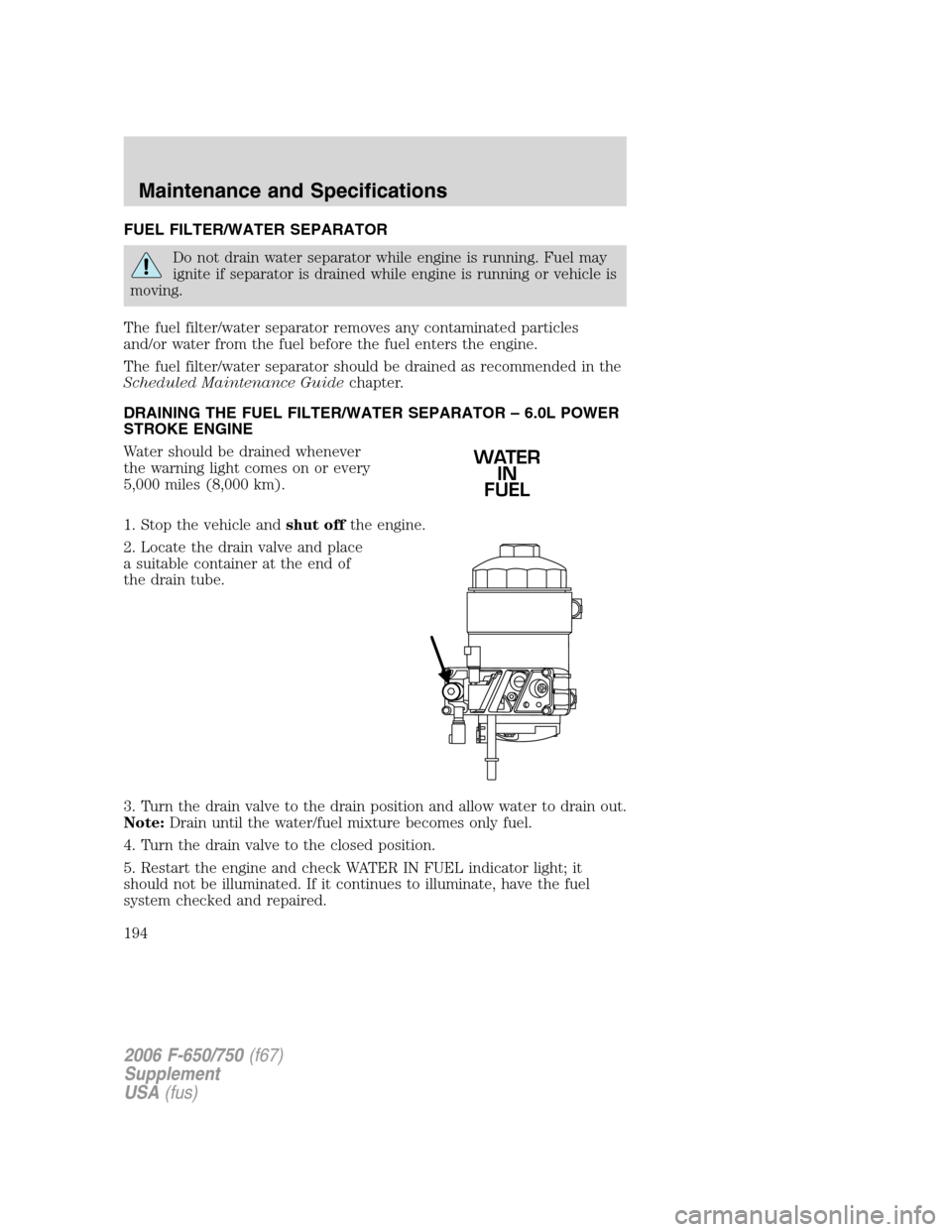
FUEL FILTER/WATER SEPARATOR
Do not drain water separator while engine is running. Fuel may
ignite if separator is drained while engine is running or vehicle is
moving.
The fuel filter/water separator removes any contaminated particles
and/or water from the fuel before the fuel enters the engine.
The fuel filter/water separator should be drained as recommended in the
Scheduled Maintenance Guidechapter.
DRAINING THE FUEL FILTER/WATER SEPARATOR – 6.0L POWER
STROKE ENGINE
Water should be drained whenever
the warning light comes on or every
5,000 miles (8,000 km).
1. Stop the vehicle andshut offthe engine.
2. Locate the drain valve and place
a suitable container at the end of
the drain tube.
3. Turn the drain valve to the drain position and allow water to drain out.
Note:Drain until the water/fuel mixture becomes only fuel.
4. Turn the drain valve to the closed position.
5. Restart the engine and check WATER IN FUEL indicator light; it
should not be illuminated. If it continues to illuminate, have the fuel
system checked and repaired.
WATER
IN
FUEL
2006 F-650/750(f67)
Supplement
USA(fus)
Maintenance and Specifications
194
Page 204 of 272

•Turbocharger-to-charge air cooler
•Charge air cooler-to-intake manifold pipe
•Mounting bracket
•Chassis-mounted charge air cooler core
Inspect air intake piping
•Check for accumulation of salt deposits (where applicable). If present,
disassemble and clean the complete air intake piping system. If the
intake piping is pitted, use Motorcraft Silicone Gasket and Sealant
TA-30 to seal joints against leakage.
•Check for loose hoses and clamps.
•Check for ruptured or collapsed hoses.
•Check air cleaner housing for cracks.
ELECTRICAL SYSTEM INSPECTIONS
Periodically inspect electrical connectors on the outside of the cab, on
the engine and frame for corrosion and tightness. Exposed terminals
such as the fuel sender, cranking motor, alternator and feed-through
studs should be cleaned and re-coated with a lubricant sealing grease
such as Motorcraft Silicone Brake Caliper Grease and Dielectic
Compound XG-3, or equivalent. This should include the ground cable
connector for batteries, engine and cab as well as the jump starting stud.
Accessory feed connections
Vehicle electrical systems are complex and often include electronic
components such as engine and transmission controls, instrument panels,
ABS, etc. While most systems operate on battery voltage (12 volts),
some systems can be as high as 90 volts or as low as five volts. Refer to
the Electrical Circuit Diagram Manuals, available from your vehicle’s
manufacturer, to ensure that any additional body lights and accessories
are connected to circuits that are both appropriate and not overloaded.
No modification should be made to any vehicle control system without
first contacting your dealer.
SUSPENSION INSPECTION
Note:Do not adjust air suspension height to any setting other than the
specified setting. Altering the height setting will change the driveline
angle and may result in unwarrantable component damage, such as
transmission component damage.
2006 F-650/750(f67)
Supplement
USA(fus)
Maintenance and Specifications
204
Page 229 of 272
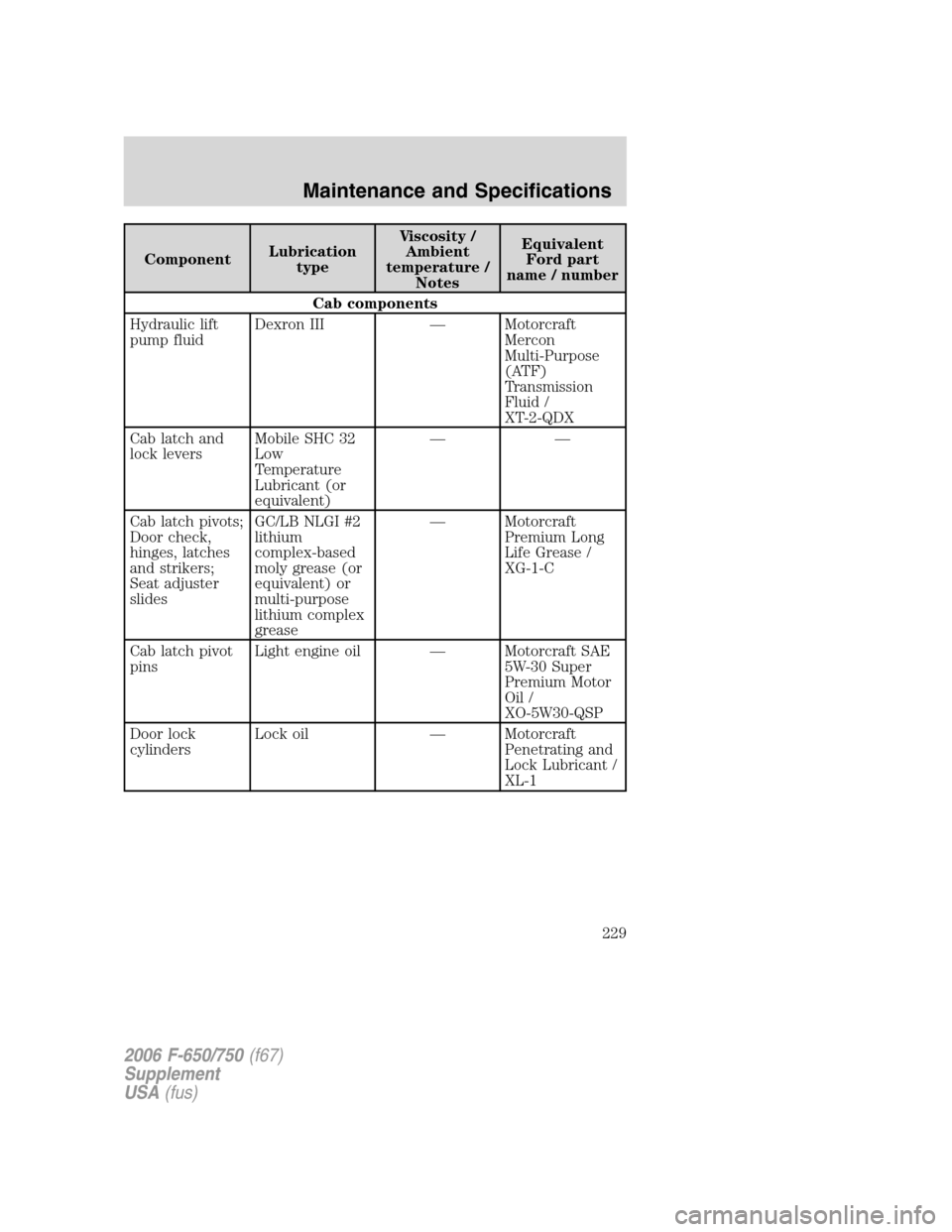
ComponentLubrication
typeViscosity /
Ambient
temperature /
NotesEquivalent
Ford part
name / number
Cab components
Hydraulic lift
pump fluidDexron III — Motorcraft
Mercon
Multi-Purpose
(ATF)
Transmission
Fluid /
XT-2-QDX
Cab latch and
lock leversMobile SHC 32
Low
Temperature
Lubricant (or
equivalent)——
Cab latch pivots;
Door check,
hinges, latches
and strikers;
Seat adjuster
slidesGC/LB NLGI #2
lithium
complex-based
moly grease (or
equivalent) or
multi-purpose
lithium complex
grease— Motorcraft
Premium Long
Life Grease /
XG-1-C
Cab latch pivot
pinsLight engine oil — Motorcraft SAE
5W-30 Super
Premium Motor
Oil /
XO-5W30-QSP
Door lock
cylindersLock oil — Motorcraft
Penetrating and
Lock Lubricant /
XL-1
2006 F-650/750(f67)
Supplement
USA(fus)
Maintenance and Specifications
229
Page 241 of 272
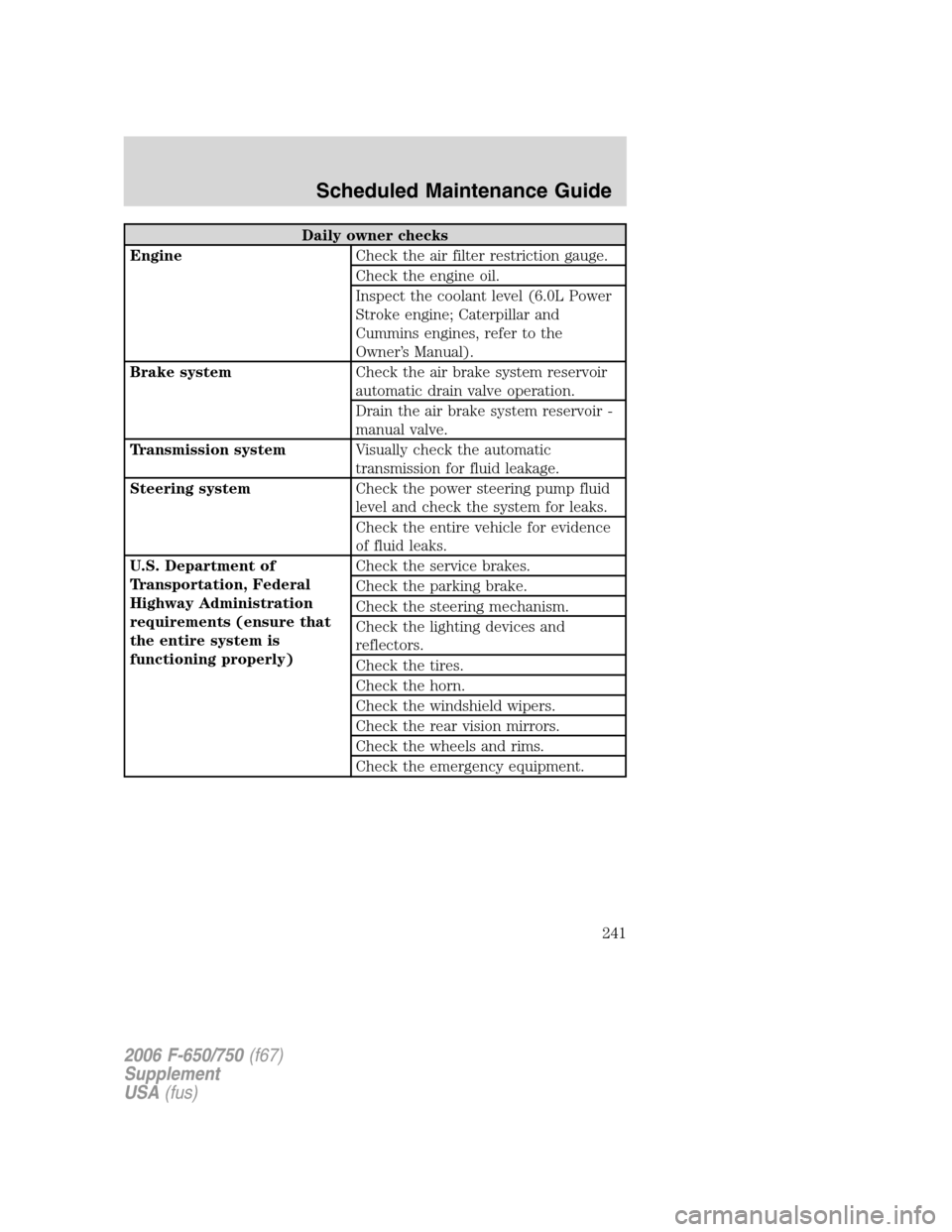
Daily owner checks
EngineCheck the air filter restriction gauge.
Check the engine oil.
Inspect the coolant level (6.0L Power
Stroke engine; Caterpillar and
Cummins engines, refer to the
Owner’s Manual).
Brake systemCheck the air brake system reservoir
automatic drain valve operation.
Drain the air brake system reservoir -
manual valve.
Transmission systemVisually check the automatic
transmission for fluid leakage.
Steering systemCheck the power steering pump fluid
level and check the system for leaks.
Check the entire vehicle for evidence
of fluid leaks.
U.S. Department of
Transportation, Federal
Highway Administration
requirements (ensure that
the entire system is
functioning properly)Check the service brakes.
Check the parking brake.
Check the steering mechanism.
Check the lighting devices and
reflectors.
Check the tires.
Check the horn.
Check the windshield wipers.
Check the rear vision mirrors.
Check the wheels and rims.
Check the emergency equipment.
2006 F-650/750(f67)
Supplement
USA(fus)
Scheduled Maintenance Guide
241
Page 267 of 272
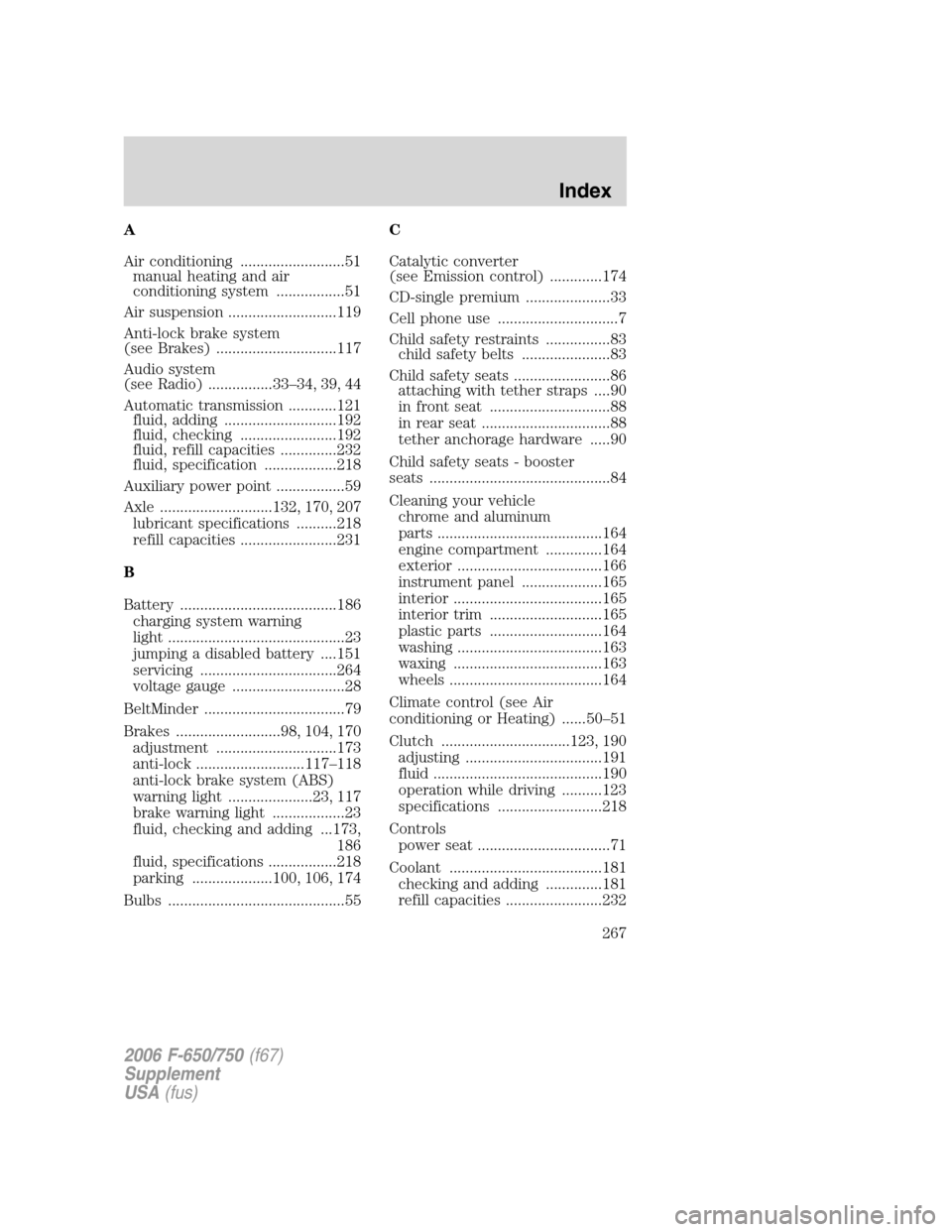
A
Air conditioning ..........................51
manual heating and air
conditioning system .................51
Air suspension ...........................119
Anti-lock brake system
(see Brakes) ..............................117
Audio system
(see Radio) ................33–34, 39, 44
Automatic transmission ............121
fluid, adding ............................192
fluid, checking ........................192
fluid, refill capacities ..............232
fluid, specification ..................218
Auxiliary power point .................59
Axle ............................132, 170, 207
lubricant specifications ..........218
refill capacities ........................231
B
Battery .......................................186
charging system warning
light ............................................23
jumping a disabled battery ....151
servicing ..................................264
voltage gauge ............................28
BeltMinder ...................................79
Brakes ..........................98, 104, 170
adjustment ..............................173
anti-lock ...........................117–118
anti-lock brake system (ABS)
warning light .....................23, 117
brake warning light ..................23
fluid, checking and adding ...173,
186
fluid, specifications .................218
parking ....................100, 106, 174
Bulbs ............................................55C
Catalytic converter
(see Emission control) .............174
CD-single premium .....................33
Cell phone use ..............................7
Child safety restraints ................83
child safety belts ......................83
Child safety seats ........................86
attaching with tether straps ....90
in front seat ..............................88
in rear seat ................................88
tether anchorage hardware .....90
Child safety seats - booster
seats .............................................84
Cleaning your vehicle
chrome and aluminum
parts .........................................164
engine compartment ..............164
exterior ....................................166
instrument panel ....................165
interior .....................................165
interior trim ............................165
plastic parts ............................164
washing ....................................163
waxing .....................................163
wheels ......................................164
Climate control (see Air
conditioning or Heating) ......50–51
Clutch ................................123, 190
adjusting ..................................191
fluid ..........................................190
operation while driving ..........123
specifications ..........................218
Controls
power seat .................................71
Coolant ......................................181
checking and adding ..............181
refill capacities ........................232
2006 F-650/750(f67)
Supplement
USA(fus)
Index
267
Page 269 of 272

Headlamps ...................................53
aiming ........................................54
daytime running lights .............53
high beam .................................53
warning chime ..........................23
Heating ..................................50–51
heater only system ...................50
manual heating and air
conditioning system .................51
Hood ..........................................175
I
Ignition .........................................91
chime .........................................23
Infant seats (see Safety seats) ..86
Instrument panel
cleaning ...................................165
lighting up panel and
interior .......................................54
J
Jump-starting your vehicle ......151
K
Keys
key in ignition chime ...............23
positions of the ignition ...........91
L
Lamps
bulb replacement
specifications chart ..................55
cargo lamps ...............................54
daytime running light ...............53
headlamps .................................53
high beams ................................53instrument panel, dimming .....54
interior lamps ...........................55
replacing bulbs ...................55–57
Lane change indicator
(see Turn signal) ........................54
Lights, warning and indicator ....23
air suspension ...........................23
anti-lock brakes (ABS) ....23, 117
brake ..........................................23
charging system ........................23
safety belt .................................23
service engine soon ..................23
traction control off ...................23
turn signal indicator .................23
Lubricant specifications ...........218
M
Manual transmission .................125
lubricant specifications ..........218
Mirrors .........................................61
fold away ...................................63
heated ........................................62
side view mirrors (power) .......61
O
Odometer .....................................28
P
Paint chips, repairing ...............163
Parking brake ....................100, 106
warning light .............................23
Power door locks ........................67
Power mirrors .............................61
Power point .................................59
Power steering ..........................189
fluid, checking and adding ....189
2006 F-650/750(f67)
Supplement
USA(fus)
Index
269